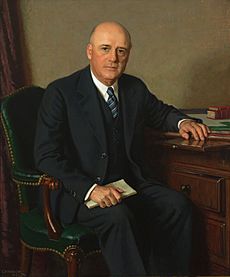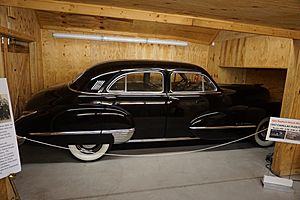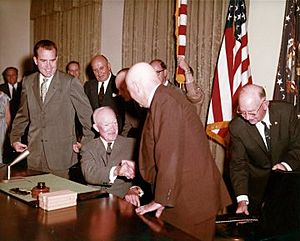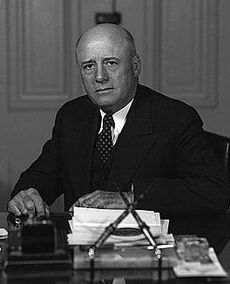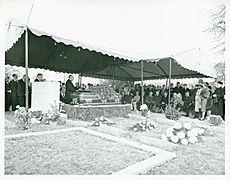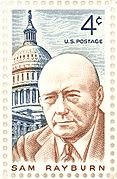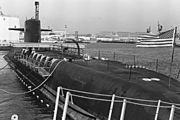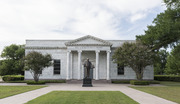Sam Rayburn facts for kids
Quick facts for kids
Sam Rayburn
|
|
|---|---|
 |
|
| 43rd Speaker of the United States House of Representatives | |
| In office January 3, 1955 – November 16, 1961 |
|
| Preceded by | Joseph W. Martin Jr. |
| Succeeded by | John W. McCormack |
| In office January 3, 1949 – January 3, 1953 |
|
| Preceded by | Joseph W. Martin Jr. |
| Succeeded by | Joseph W. Martin Jr. |
| In office September 16, 1940 – January 3, 1947 |
|
| Preceded by | William B. Bankhead |
| Succeeded by | Joseph W. Martin Jr. |
| 37th Dean of the United States House of Representatives | |
| In office January 3, 1953 – November 16, 1961 |
|
| Preceded by | Robert L. Doughton |
| Succeeded by | Carl Vinson |
| House Minority Leader | |
| In office January 3, 1953 – January 3, 1955 |
|
| Deputy | John W. McCormack |
| Preceded by | Joseph W. Martin Jr. |
| Succeeded by | Joseph W. Martin Jr. |
| In office January 3, 1947 – January 3, 1949 |
|
| Deputy | John W. McCormack |
| Preceded by | Joseph W. Martin Jr. |
| Succeeded by | Joseph W. Martin Jr. |
| Leader of the House Democratic Caucus | |
| In office September 16, 1940 – November 16, 1961 |
|
| Preceded by | William B. Bankhead |
| Succeeded by | John W. McCormack |
| House Majority Leader | |
| In office January 3, 1937 – September 16, 1940 |
|
| Deputy | Patrick J. Boland |
| Preceded by | William B. Bankhead |
| Succeeded by | John William McCormack |
| Chair of the Committee on Interstate and Foreign Commerce | |
| In office March 4, 1931 – January 3, 1937 |
|
| Preceded by | James S. Parker |
| Succeeded by | Clarence F. Lea |
| Chair of the House Democratic Caucus | |
| In office March 4, 1921 – March 4, 1923 |
|
| Leader | Claude Kitchin |
| Preceded by | Arthur G. DeWalt |
| Succeeded by | Henry T. Rainey |
| Member of the U.S. House of Representatives from Texas's 4th district |
|
| In office March 4, 1913 – November 16, 1961 |
|
| Preceded by | Choice B. Randell |
| Succeeded by | Ray Roberts |
| Speaker of the Texas House of Representatives | |
| In office January 10, 1911 – January 14, 1913 |
|
| Preceded by | John Wesley Marshall |
| Succeeded by | Chester H. Terrell |
| Member of the Texas House of Representatives from the 34th district |
|
| In office January 8, 1907 – January 14, 1913 |
|
| Preceded by | Rosser Thomas |
| Succeeded by | Robert Reuben Williams |
| Personal details | |
| Born |
Samuel Taliaferro Rayburn
January 6, 1882 Kingston, Tennessee, U.S. |
| Died | November 16, 1961 (aged 79) Bonham, Texas, U.S. |
| Political party | Democratic |
| Spouse |
Metze Jones
(m. 1927; div. 1927) |
| Alma mater | East Texas Normal College University of Texas School of Law |
| Profession | Lawyer |
Samuel Taliaferro Rayburn (January 6, 1882 – November 16, 1961) was an American politician. He served as the 43rd Speaker of the United States House of Representatives. He was Speaker three times and was also a House majority leader and minority leader. Rayburn was a congressman for 24 terms, representing Texas's 4th congressional district as a Democrat from 1913 to 1961. He holds the record for the longest time as Speaker of the United States House of Representatives, serving for over 17 years.
Rayburn was born in Roane County, Tennessee. His family moved to Windom, Texas, in 1887. After teaching for a while, Rayburn was elected to the Texas House of Representatives. He also graduated from the University of Texas School of Law. He was elected to the U.S. House of Representatives in 1912 and kept winning re-election until he died in 1961. He served a total of 25 terms. Rayburn was a close helper to John Nance Garner and a guide to Lyndon B. Johnson.
Rayburn became House Majority Leader in 1937. He then became Speaker of the House after William B. Bankhead died. He led the House Democrats from 1940 to 1961. He was Speaker from 1940 to 1947, 1949 to 1953, and 1955 to 1961. Rayburn also served twice as House Minority Leader (1947 to 1949 and 1953 to 1955) when Republicans controlled the House. He liked to work quietly and used his ability to persuade others to pass bills.
With Senate Majority Leader Lyndon Johnson, Rayburn did not sign the 1956 Southern Manifesto. He helped pass the Civil Rights Acts of 1957 and 1960. These were the first civil rights bills passed by the U.S. Congress since the Reconstruction Era (1863–1877). Rayburn also helped build U.S. Route 66. He served as Speaker until his death in 1961 and was followed by John W. McCormack. He is the most recent Speaker of the House to die while in office.
Contents
Early Life and Education
Rayburn was born in Roane County, Tennessee, on January 6, 1882. His family moved to a 40-acre cotton farm near Windom, Texas, in 1887. Rayburn grew up in a poor family. He and his nine brothers and sisters worked on the farm. Working hard in the fields made Rayburn want to get a good education. He wanted to help people who were poor and struggling.
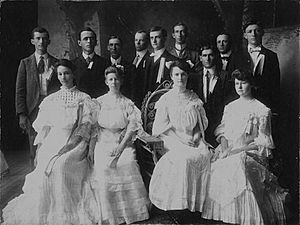
In 1900, Rayburn went to East Texas Normal College (now Texas A&M University–Commerce) in Commerce, Texas. His father saved $25 (about $750 today) to help with his first few months of college. To pay for school, Rayburn rang the school bell and swept school buildings. He earned $3 a month. Rayburn became a teacher before he finished his degree. He also taught in Greenwood, Texas, to earn more money. He graduated in 1903 and taught school for two years.
Texas State Legislature
In 1906, at age 24, Rayburn won an election to the 34th district of the Texas House of Representatives. He won by only 163 votes. While serving in the legislature, he studied at the University of Texas School of Law. He became a lawyer in 1908.
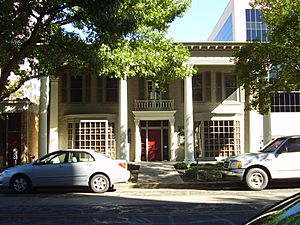
As a representative, Rayburn helped pass laws to make textbooks more available for Texas schoolchildren. He also helped create the State Board of Health and the Texas Department of Agriculture. Because he was good at persuading people, Rayburn became the youngest Speaker of the Texas House of Representatives in history on January 10, 1911, at age 29. He won the speaker election 70 to 63.
Before Rayburn, Texas Speakers mostly had ceremonial roles. But the law actually gave the office a lot of power. Rayburn asked for a special committee to define the Speaker's duties and rights. This was the first time the Speaker's power was officially written down. As Speaker, he helped pass laws for shorter working hours for women and child labor laws. He also helped fund homes for Confederate widows and a tuberculosis hospital. Years later, Rayburn said his time as Texas House Speaker was the most enjoyable part of his political career. He said, "that job had real power—that's what a man wants—but power's no good unless you have the guts to use it."
U.S. House of Representatives
In 1912, Rayburn had a chance to run for the U.S. House of Representatives. The representative for his home district, the fourth district, was leaving. Rayburn won the election and became a Representative in 1913. This was at the start of Woodrow Wilson's presidency. He served for almost 49 years, until the start of John F. Kennedy's presidency.
Rayburn was a close helper to then-Representative John Nance Garner. Even though Rayburn was new, Garner helped him join the powerful House Interstate and Foreign Commerce Committee in 1913. This committee handled laws about trade, bridges, oil, communication, and more. Rayburn learned how to make deals during his first 20 years in the House. As a young representative, he helped pass laws against monopolies and about railroads.
After only eight years in the House, Rayburn was elected House Democratic Caucus Chairman. He served from 1921 to 1923. At 39, he was the youngest person ever elected to that job. In the 1920s, Rayburn kept a low profile because Republicans controlled Congress and the Presidency. His biggest help in this time was creating the U.S. Highway System in 1926. This was a big step in his dream to have paved roads for all Americans.

Rayburn managed Garner's campaign during the 1932 presidential election. He helped Garner's supporters vote for Roosevelt after a deal was made for Garner to become the vice-presidential candidate.
From 1931 to 1937, Rayburn was Chairman of the House Interstate and Foreign Commerce Committee. In this role, he helped pass important New Deal laws. These included laws that created the Securities and Exchange Commission and the Federal Communications Commission. He also helped pass the Public Utilities Holding Company Act and the Rural Electrification Act.
Rayburn strongly supported projects that helped farmers and people in rural areas. These included dams and farm-to-market roads. He helped create new lakes like Lake Texoma and turn dirt roads into paved ones. This earned him strong support from his voters. Dams helped control floods and made electricity. The Flood Control Act of 1936 and the Rural Electrification Act helped bring electricity to 90% of rural America by 1959. In the early 1930s, only 3% had electricity. Rayburn also helped create the Soil Conservation Service and the Civilian Conservation Corps. These groups worked to control water and soil erosion, which was a big problem after events like the Dust Bowl.
Speaker of the House
On September 16, 1940, at age 58, Rayburn became Speaker of the House. This happened after Speaker William Bankhead died suddenly. Rayburn's rise to Speaker was quick. The three Speakers before him had all died in office within six years.
Rayburn's first big challenge as Speaker was World War II. Before the war, the United States wanted to stay out of it. Rayburn helped pass the Lend-Lease Act in March 1941. This law allowed the U.S. to send food, oil, and supplies to the United Kingdom, China, and the Soviet Union. In August 1941, he helped pass the Service Extension Act of 1941. In 1940, a 12-month peacetime draft was started to prepare for war. Some in the House wanted the draft to end after 12 months. Rayburn talked to many representatives and persuaded them to change their minds. The bill passed by only one vote (203–202). If it had failed, the U.S. Army would have lost most of its soldiers and officers.
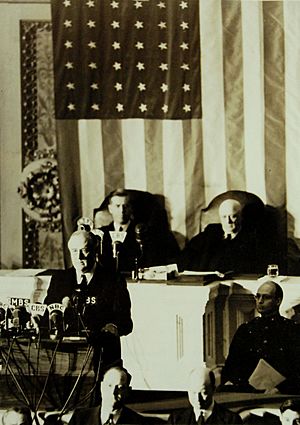
In early 1944, President Roosevelt's top officials asked Rayburn to secretly get money from Congress for an atomic bomb. Later that year, Rayburn secured $1.6 billion for the Manhattan Project. This was the secret project to create the atomic bomb. Most of the President's cabinet, vice presidents, and almost all members of Congress did not know about it. Only Rayburn, the Senate Majority Leader, and five other congressmen knew. Rayburn had to hide the project's funding in other bills until the bombs were used in 1945.
In 1946, Republicans won control of both the House and Senate in the midterm elections. Democrats lost 54 seats in the House. Rayburn felt he should step down as House Democratic Leader. But President Truman and other Democrats wanted him to stay. They felt that without Rayburn, the Democratic Party would be divided. Rayburn agreed to stay as Minority Leader. To show their thanks, 142 House Democrats and 50 House Republicans surprised Rayburn with a 1947 Cadillac. The Speaker usually had a government car, and they felt bad that Rayburn, as Minority Leader, would not. Rayburn had a rule not to accept gifts worth more than $25. The congressmembers got around this by each giving $25. Rayburn returned the checks from the 50 Republican representatives to avoid any conflicts of interest.
From 1947–48, Rayburn, as Minority Leader, helped pass the Marshall Plan. This plan provided aid to non-communist European countries and helped stop the spread of communism. He also dealt with southern Democrats (Dixiecrats) who opposed President Truman's quick civil rights laws. Rayburn was a moderate. He rejected Truman's very fast civil rights bills but also told southern Democrats not to run a third-party candidate in the 1948 presidential election. Rayburn was a strong supporter of Truman. He wanted civil rights laws to be passed gradually to avoid strong opposition from southern Democrats. In 1949, after helping Democrats win back the House and Senate, he became Speaker again. He then supported ending the poll tax in Texas. He said it would help the U.S. in its fight against the Soviet Union.
From 1949 to 1953, Rayburn was Speaker again. He supported Truman's Fair Deal. However, a group of conservative Republicans and Democrats blocked many of these laws. During this time, he focused on anti-Soviet laws and getting House support for Truman and the military in the Korean War. By 1952, the Korean War was difficult, and Truman's popularity dropped. Truman did not run for re-election, and Republicans won the House, Senate, and presidency.
Rayburn's second time as Minority Leader was during President Eisenhower's first two years. Both parties wanted to show they were against communism. Rayburn and most Democrats supported the Communist Control Act of 1954 and continued to defend South Korea and Taiwan. Rayburn and the Democrats won back the House and Senate in the 1954 elections.
Rayburn's third and final time as Speaker, from 1955 to 1961, was a highlight of his career. His protégé, Senator Lyndon B. Johnson, became Majority Leader thanks to Rayburn's efforts. Rayburn, Eisenhower, and Johnson worked well together. They passed many important laws. These included the National Interstate and Defense Highways Act (which created the Interstate Highway System), the National Aeronautics and Space Act (which created NASA), and the Federal Aviation Act of 1958 (which created the FAA). They also passed the Civil Rights Act of 1957 and the Civil Rights Act of 1960. These were the first civil rights acts passed since Reconstruction.
In 1958–59, Rayburn helped Alaska and Hawaii become the 49th and 50th states. Rayburn strongly supported Alaska. He knew that Democratic Alaska would balance Republican Hawaii in the Senate and Electoral College. In 1961, Rayburn wanted to pass more civil rights laws with President Kennedy. But the powerful House Rules Committee was controlled by a group of conservative Democrats and Republicans who blocked these laws. Rayburn worked to change the House rules to add three spots to the committee. Rayburn gave a rare speech on the House floor to defend his plan. He said, "I think this House should be allowed on great measures to work its will and it cannot work its will if the Committee on Rules is so constituted as not to allow the House to pass on those things." Rayburn and the Democratic leaders won by a close vote of 217–212.
Rayburn was a close friend and mentor to Lyndon B. Johnson. He knew Johnson's father from their time in the Texas Legislature. Rayburn was key to Lyndon Johnson's rise to power, especially his quick move to Minority Leader. Johnson had only been in the Senate for four years when he took on this role. Johnson also owed his later promotion to Majority Leader to Rayburn. Like Johnson, Rayburn did not sign the Southern Manifesto.
As Speaker, Rayburn built strong friendships with leaders of new independent countries and democracies in Africa, especially Nigeria. Rayburn was a good friend of Jaja Wachuku, the first Speaker of the Nigerian House of Representatives, from 1959 to 1960.
Personal Integrity
Many Texas lawmakers at the time were paid by large companies. But Rayburn always refused to take money from clients who had business before the legislature. This was very unusual back then. Later, while in Congress, a rich oil man sent a very expensive horse to Rayburn's farm. Rayburn returned the horse.
H.G. Dulaney, an aide to Rayburn, said that after a speech in Texas, Rayburn learned his driver had been given money. Rayburn made the driver turn around and return the money. Author Robert Caro said, "No one could buy him. Lobbyists could not buy him so much as a meal." Rayburn would say, "I'm not for sale."
Legacy
Rayburn liked to work quietly behind the scenes rather than be in the public eye. As Speaker, he was known for being fair and honest. Throughout his years in Congress, Rayburn always paid his own expenses. He even paid for his own travel when inspecting the Panama Canal, even though the government would have paid for it. When he died, his property was worth just under $300,000, mostly land. He had about $26,000 in cash.
Rayburn was famous among his colleagues for his "Board of Education" meetings. These were informal gatherings in hidden offices in the House after work hours. The Speaker and powerful committee leaders would meet for poker, drinks, and honest talks about politics. Only Rayburn decided who was invited. Being invited was a great honor. On April 12, 1945, Vice President Harry Truman, who often attended, was at one of these meetings when he got a call to go to the White House. There, he learned that Franklin D. Roosevelt had died, and he was now President.
Rayburn created the term "Sun Belt" while strongly supporting the building of Route 66. He famously said that America must connect "the Frost Belt with the Sun Belt."
Rayburn also knew how to dress for the occasion. In Washington, D.C., he wore expensive suits. But back in his poorer district in Texas, he wore simple shirts, blue jeans, and cowboy boots.
The saying "A jackass can kick a barn down, but it takes a carpenter to build one" is believed to be from Rayburn.
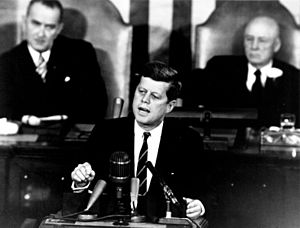
His home in Texas, now the Sam Rayburn House Museum, is a U.S. National Historic Landmark. In 1957, Rayburn opened the Sam Rayburn Library and Museum in Bonham. It was built like a presidential library to keep his memory, books, and awards.
Personal Life and Death
Rayburn married once to Metze Jones (1901–1982). She was the sister of his friend, Congressman Marvin Jones. They had written letters for nine years. When they married in 1927, Rayburn was 45 and Jones was 26. Their marriage ended after only a few months. Biographers believe Rayburn's busy work schedule and long time as a bachelor, along with their different views, led to the split. Rayburn rarely spoke about his short marriage.
In 1956, Rayburn was baptized in the Primitive Baptist Church.
One of his biggest regrets was not having a son, or as he said, "a towheaded boy to take fishing."
Rayburn died of pancreatic cancer in 1961 at age 79. He was given the Congressional Gold Medal after his death. His funeral in Bonham, Texas, was a large event. Many important people attended, including President John F. Kennedy, former presidents Harry S. Truman and Dwight Eisenhower, and Vice President Lyndon B. Johnson. Hundreds of members of Congress also attended. President Kennedy was an honorary pallbearer. By the time he died, he had served as Speaker for almost twice as long as anyone before him.
Sam Rayburn was close friends with Professor Tarter, a wood shop instructor at East Texas State Teachers College (now Texas A&M University–Commerce). Rayburn had his own room in the Tarter family's house when he visited his district. This house is still at 1910 Monroe St., Commerce, TX.
Rayburn was a descendant of George Waller, a Revolutionary War officer. He was an honorary president of the Colonel George Waller Chapter of the Sons of the American Revolution.
Tributes
-
A stamp issued by the United States Post Office Department
Places and Things Named After Sam Rayburn
- Rayburn House Office Building: This building near the United States Capitol has offices for House members. It was finished in 1965.
- Nuclear ballistic missile submarine USS Sam Rayburn: This submarine was launched in 1963.
- Sam Rayburn Reservoir: This lake in East Texas was started in 1956 and renamed after Rayburn in 1963.
- Sam Rayburn, Texas: A community named after the reservoir.
- Sam Rayburn High School: A high school in Pasadena, Texas, opened in 1964.
- Sam Rayburn Independent School District: A school district in Ivanhoe, Texas, started in 1964.
- Sam Rayburn Memorial Student Center: At Texas A&M University–Commerce, built in 1963. A new center replaced it in 2009.
- Sam Rayburn Intermediate School: In Bryan, Texas.
- Sam Rayburn Middle School: In San Antonio, Texas.
- Sam Rayburn Freeway: Part of U.S. Highway 75 that goes through Sherman, Texas.
- Sam Rayburn Tollway: A toll road in the Dallas-Fort Worth Metroplex that runs through Dallas, Denton, and Collin counties in northeast Texas.
- Sam Rayburn Memorial Highway: About 40 miles of Texas State Highway 121.
- Sam Rayburn Elementary School: In McAllen, Texas.
- Sam Rayburn Elementary School: In Grand Prairie, Texas.
- Sam Rayburn Memorial Veterans Center: In Bonham, Texas.
- The Rayburn Room: A meeting room at The Greenbrier in White Sulphur Springs, West Virginia.
- Sam Rayburn Drive: Part of Texas State Highway 56 that goes through Bonham, Texas.
- The Rayburn Room: A large reception room at the United States Capitol where congressmembers can meet with the press or people visiting.
Portrayals in Media
- Pat Hingle played Rayburn in the 1987 TV movie LBJ: The Early Years.
- James Gammon played him in the 1995 HBO movie Truman.
See Also
- List of Freemasons
- Wahrenberger House
- List of United States Congress members who died in office (1950–99)



